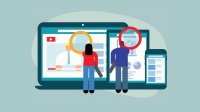Why Teaching Media Literacy Is Essential
Media literacy lessons can help high school students develop critical thinking skills as they question what they see online.
Your content has been saved!
Go to My Saved Content.As an educator who helps colleagues with their media literacy teaching, I offer this lesson designed for high school students.
I show students a video that arouses an emotional response, especially when the video reaches its climax, the man saving the dog in extremis from the chugging train. It’s engaging, it’s on TikTok, and students love it. I have their attention.
I then ask them if it’s real or fake, requesting that they pay closer attention before I play it again. Claims are made, shouted out from the four corners of the class. Engagement and emotions are high. We check the video comments; many don’t question its veracity, commenting instead on the heroics of the man who saved the dog.
I ask the students to look more closely. The astute ones notice that the long shadow of the train on the puffing figure of the man lying relieved on the ground at the end shouldn’t be there. It is indeed a fake.
That’s the easy part. It gets more difficult when I ask students why they think this fake content was created. Excited students are suddenly more subdued, facial expressions telling me they are thinking. They collectively brainstorm—there are no right or wrong claims here for now.
Is it illegal to be overweight in Japan?
I then show them the headline of another video. It’s shocking, it’s engaging, it makes you want to click and watch. Could this really be true? I ask for a quick show of hands to see whether they want to view the video. A majority say yes.
We watch together and then hark back to the title. Is it illegal to be overweight in Japan? The video does not suggest that, but I ask them to search for more information online. They do a good job, finding worthy and untrustworthy sources, concluding as a group that the headline is misleading. No, it’s not illegal, but citizens in Japan from the ages of 40 to 74 are required to undergo yearly weight exams.
Someone wrote this title—what was their motivation for writing a misleading one? “Because they want people to click on it,” a pupil exclaims. I prompt them to go further, thinking in parallel about the motivations of the person who created the fake video we watched earlier.
“Because they want to make money.”
I smile.
The ‘why’ in critical thinking
Learning is (too) often a checkbox experience. We have a set of targets, rubrics, and deadlines to meet. Spotting a fake? Check! Pointing out a misleading title? Check! Verifying claims and checking sources? Check! These are all “technical” skills we need to teach, but what about the why?
By cultivating the why, students are developing their critical thinking, taking a stand, shaking up the status quo. We aim to provide them with the tools to question why social media apps are so addictive in the first place, why many web apps are—on the surface—free, why misleading titles—clickbait—pepper our online experience.
Going further in the why exposes a more profound knowledge of how information spreads online. Why are stories online usually negative? Why are there bots creating and sharing content? It touches upon seemingly sparse elements—from human psychology to the ad-based data model of the web, from our instinct to be attracted to sensationalist headlines to our tendency to keep scrolling aimlessly. They all, however, fit into one jigsaw puzzle.
Pieces of the puzzle: Back to the classroom. With the help of an AI chatbot, we imagine a breaking news story of a protest in a big city along with clashes between protesters and the police. In groups, students are assigned pieces of the puzzle. One group is asked to write up clickbait headlines; another is asked to create viral misleading social media posts. Some look into creating fake accounts on various social media outlets; others are assigned with imagining how left- and right-wing media outlets would portray the event. One last group creates AI-powered fake images of the event using one of the many tools now available for this.
The ability to explain is a key component of critical thinking, and the class listens as groups later on not only present their output, but also show the process and steps they took to reach their final output. Each is followed by a feedback session. From day one, I’ve tried to foster open discussions, argumentation, and self-reflection, and these moments are key in this, with students leading the way in providing observations, as well as suggestions for improvement. Explaining how they came up with this or that is fundamental.
Learning how to think critically involves the ability to understand how these puzzle pieces fit together, so we draw a mind map on the board and connect the dots. Students are starting to see that misinformation is much more than simply spotting a fake.
The students of tomorrow will undoubtedly grow up in a web that will be radically different from this one, but no matter the tech, their ability to think critically will lead them to understand, question, and challenge.
The why will be as relevant then as it is now.
